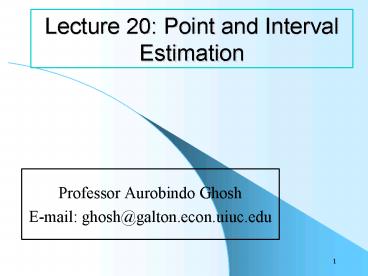Lecture 20: Point and Interval Estimation - PowerPoint PPT Presentation
1 / 16
Title:
Lecture 20: Point and Interval Estimation
Description:
Statistical inference is the process by which we acquire information about ... types of television programs and commercials targeted at children is affected by ... – PowerPoint PPT presentation
Number of Views:119
Avg rating:3.0/5.0
Title: Lecture 20: Point and Interval Estimation
1
Lecture 20 Point and Interval Estimation
- Professor Aurobindo Ghosh
- E-mail ghosh_at_galton.econ.uiuc.edu
2
Introduction
- Statistical inference is the process by which we
acquire information about populations from
samples. - There are two procedures for making inferences
- Estimation.
- Hypotheses testing.
3
Concepts of Estimation
- The objective of estimation is to determine the
value of a population parameter on the basis of a
sample statistic. - There are two types of estimators
- Point Estimator
- Interval estimator
4
Point Estimator
- A point estimator draws inference about a
population by estimating the value of an unknown
parameter using a single value or a point.
5
- Point Estimator
- A point estimator draws inference about a
population by estimating the value of an unknown
parameter using a single value or a point.
Parameter
Population distribution
?
Sample distribution
Point estimator
6
Interval Estimator
- An interval estimator draws inferences about a
population by estimating the value of an unknown
parameter using an interval. - The interval estimator is affected by the sample
size.
Interval estimator
7
- Selecting the right sample statistic to estimate
a parameter value depends on the characteristics
of the statistics.
- Estimators desirable characteristics
- Unbiasedness An unbiased estimator is one whose
expected value is equal to the parameter it
estimates. - Consistency An unbiased estimator is said to be
consistent if the difference between the
estimator and the parameter grows smaller as the
sample size increases. - Relative efficiency For two unbiased estimators,
the one with a smaller variance is said to be
relatively efficient.
8
Estimating the Population Mean when the
Population Standard Deviation is Known
- How is an interval estimator produced from a
sampling distribution? - To estimate m, a sample of size n is drawn from
the population, and its mean is calculated. - Under certain conditions, is normally
distributed (or approximately normally
distributed.), thus
9
- We know that
- This leads to the relationship
10
1 - a
Upper confidence limit
Lower confidence limit
See simulation results demonstrating this point
11
- The confidence interval are correct most, but
not all, of the time.
UCL
LCL
Not all the confidence intervals cover the real
expected value of 100.
100
0
The selected confidence level is 90, and 10 out
of 100 intervals do not cover the real m.
12
- Four commonly used confidence levels
za/2
The mean values obtained in repeated draws of
samples of size 100 result in interval
estimators of the form sample mean - .28,
Sample mean .28 90 of which cover the real
mean of the distribution.
13
- Recalculate the confidence interval for 95
confidence level. - Solution
- The width of the 90 confidence interval
2(.28) .56 - The width of the 95 confidence interval
2(.34) .68 - Because the 95 confidence interval is wider,
it is more likely to include the value of m.
.95
.90
14
- Example 9.1
- The number and the types of television programs
and commercials targeted at children is affected
by the amount of time children watch TV. - A survey was conducted among 100 North American
children, in which they were asked to record the
number of hours they watched TV per week. - The population standard deviation of TV watch was
known to be s 8.0 - Estimate the watch time with 95 confidence
level.
15
- Solution
- The parameter to be estimated is m, the mean time
of TV watch per week per child (of all American
Children). - We need to compute the interval estimator for m.
- From the data provided in file XM09-01, the
sample mean is
Since 1 - a .95, a .05. Thus a/2 .025.
Z.025 1.96
16
- Interpreting the interval estimate
- It is wrong to state that the interval
estimator is an interval for which there is 1 - a
chance that the population mean lies between the
LCL and the UCL. - This is so because the m is a parameter, not a
random variable.

